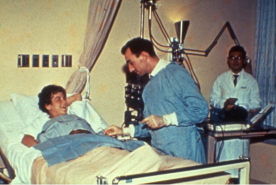If you get your dialysis at an outpatient dialysis clinic, have you been asked if you would like to learn how to insert (cannulate) your own needles for hemodialysis?
The Center for Medicare and Medicaid (CMS) policies state “Patients have the right to know and participate in their care and treatment to the extent they desire. Self-cannulation may be performed by the patient in any facility upon receiving appropriate training and demonstrating competence, should they choose.”
Now that you know your right to learn and do self-cannulation, let’s look at self-cannulation in more detail to help you decide if it is right for you. The following steps can be done at your dialysis center with a needle that has the cover over the sharp end. These steps are detailed for a lower or upper arm fistula or graft access.
- Can you grasp or hold the fistula needle with your hand opposite of your vascular access?
- Can you reach your fistula or graft with your hand while holding the needle?
- Can you reach to both the arterial (red) and venous (blue) needle locations? Note: if you can’t insert the arterial needle facing down towards your hand, your care team can consider inserting the arterial needle facing up towards your shoulder to make it easier for you to reach the right spot to insert the needle.
- Can you hold your own needle sites after dialysis?
You may want to start by learning proper skin cleaning before your needles are placed. Washing your fistula or graft with soap and water right before going to your dialysis station is a good first step. The staff can teach you the right way to use the skin cleaning solution. You can practice skin cleaning to get comfortable with hand grasp and hand/arm movement needed to reach your needle sites. If this all goes well, then your dialysis care team can determine the next steps of cannulation training. You’ll need to be trained at your learning speed, so the care team should include you in the training plan.
What are some reasons you would want to stick your own needles?
- You won’t need the staff to stick your needles. This also helps when you travel, so you don’t have to have new staff learn your access. You can put in your own needles!
- You worry about yourself. Staff must learn many patients’ fistulas or grafts, but you just need to be an expert on your own.
- You know your body best. You can feel if the needle isn’t going into the fistula or graft properly and can quickly correct.
- You’re in charge and can take control of your fistula or graft care. This could help to protect and prolong the life of your fistula or graft. Lifeline for a lifetime is the goal!
Ask your dialysis care team about learning any part of the self-cannulation steps that you have the interest in learning and doing. It just might be the right choice for you!
It only takes a minute to see if your fistula or graft is working well
The dialysis care team should check your fistula or graft every time you go for a treatment to make sure your vascular access is working well. They should look, listen, and feel your fistula or graft before the skin is cleaned. They need to use a stethoscope to listen to your “bruit,” the whooshing sound the blood makes as it flows through your fistula or graft. They will also feel for the “thrill,” the vibration/buzz of the blood moving through your fistula or graft. You should also get in the habit of checking your access every day, especially on days you don’t have dialysis treatment.








